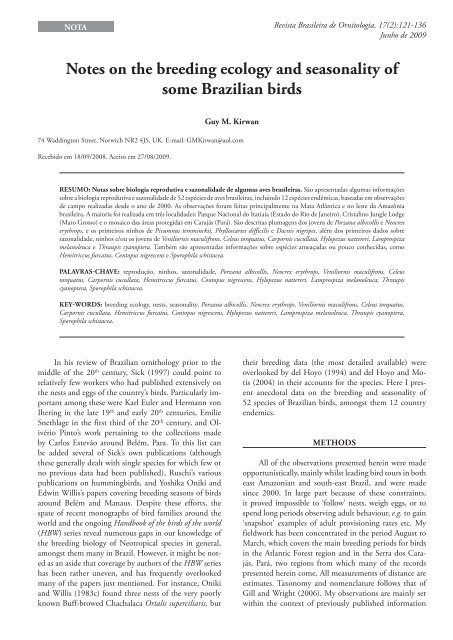art01 - omena júnior.indd - Sociedade Brasileira de Ornitologia
art01 - omena júnior.indd - Sociedade Brasileira de Ornitologia
art01 - omena júnior.indd - Sociedade Brasileira de Ornitologia
- No tags were found...
You also want an ePaper? Increase the reach of your titles
YUMPU automatically turns print PDFs into web optimized ePapers that Google loves.
NOTA Revista <strong>Brasileira</strong> <strong>de</strong> <strong>Ornitologia</strong>, 17(2):121-136Junho <strong>de</strong> 2009Notes on the breeding ecology and seasonality ofsome Brazilian birdsGuy M. Kirwan74 Waddington Street, Norwich NR2 4JS, UK. E‐mail: GMKirwan@aol.comRecebido em 18/09/2008. Aceito em 27/08/2009.Resumo: Notas sobre biologia reprodutiva e sazonalida<strong>de</strong> <strong>de</strong> algumas aves brasileiras. São apresentadas algumas informaçõessobre a biologia reprodutiva e sazonalida<strong>de</strong> <strong>de</strong> 52 espécies <strong>de</strong> aves brasileiras, incluindo 12 espécies endêmicas, baseadas em observações<strong>de</strong> campo realizadas <strong>de</strong>s<strong>de</strong> o ano <strong>de</strong> 2000. As observações foram feitas principalmente na Mata Atlântica e no leste da Amazôniabrasileira. A maioria foi realizada em três localida<strong>de</strong>s: Parque Nacional do Itatiaia (Estado do Rio <strong>de</strong> Janeiro), Cristalino Jungle Lodge(Mato Grosso) e o mosaico das áreas protegidas em Carajás (Pará). São <strong>de</strong>scritas plumagens dos jovens <strong>de</strong> Porzana albicollis e Neocrexerythrops, e os primeiros ninhos <strong>de</strong> Picumnus temminckii, Phylloscartes difficilis e Dacnis nigripes, além dos primeiros dados sobresazonalida<strong>de</strong>, ninhos e/ou os jovens <strong>de</strong> Veniliornis maculifrons, Celeus torquatus, Carpornis cucullata, Hylopezus nattereri, Lamprospizamelanoleuca e Thraupis cyanoptera. Também são apresentadas informações sobre espécies ameaçadas ou pouco conhecidas, comoHemitriccus furcatus, Contopus nigrescens e Sporophila schistacea.Palavras-Chave: reprodução, ninhos, sazonalida<strong>de</strong>, Porzana albicollis, Neocrex erythrops, Veniliornis maculifrons, Celeustorquatus, Carpornis cucullata, Hemitriccus furcatus, Contopus nigrescens, Hylopezus nattereri, Lamprospiza melanoleuca, Thraupiscyanoptera, Sporophila schistacea.Key-Words: breeding ecology, nests, seasonality, Porzana albicollis, Neocrex erythrops, Veniliornis maculifrons, Celeus torquatus,Carpornis cucullata, Hemitriccus furcatus, Contopus nigrescens, Hylopezus nattereri, Lamprospiza melanoleuca, Thraupis cyanoptera,Sporophila schistacea.In his review of Brazilian ornithology prior to themiddle of the 20 th century, Sick (1997) could point torelatively few workers who had published extensively onthe nests and eggs of the country’s birds. Particularly importantamong these were Karl Euler and Hermann vonIhering in the late 19 th and early 20 th centuries, EmilieSnethlage in the first third of the 20 th century, and OlivérioPinto’s work pertaining to the collections ma<strong>de</strong>by Carlos Estevão around Belém, Para. To this list canbe ad<strong>de</strong>d several of Sick’s own publications (althoughthese generally <strong>de</strong>alt with single species for which few orno previous data had been published), Ruschi’s variouspublications on hummingbirds, and Yoshika Oniki andEdwin Willis’s papers covering breeding seasons of birdsaround Belém and Manaus. Despite these efforts, thespate of recent monographs of bird families around theworld and the ongoing Handbook of the birds of the world(HBW) series reveal numerous gaps in our knowledge ofthe breeding biology of Neotropical species in general,amongst them many in Brazil. However, it might be notedas an asi<strong>de</strong> that coverage by authors of the HBW serieshas been rather uneven, and has frequently overlookedmany of the papers just mentioned. For instance, Onikiand Willis (1983c) found three nests of the very poorlyknown Buff-browed Chachalaca Ortalis superciliaris, buttheir breeding data (the most <strong>de</strong>tailed available) wereoverlooked by <strong>de</strong>l Hoyo (1994) and <strong>de</strong>l Hoyo and Motis(2004) in their accounts for the species. Here I presentanecdotal data on the breeding and seasonality of52 species of Brazilian birds, amongst them 12 countryen<strong>de</strong>mics.MethodsAll of the observations presented herein were ma<strong>de</strong>opportunistically, mainly whilst leading bird tours in botheast Amazonian and south-east Brazil, and were ma<strong>de</strong>since 2000. In large part because of these constraints,it proved impossible to ‘follow’ nests, weigh eggs, or tospend long periods observing adult behaviour, e.g. to gain‘snapshot’ examples of adult provisioning rates etc. Myfieldwork has been concentrated in the period August toMarch, which covers the main breeding periods for birdsin the Atlantic Forest region and in the Serra dos Carajás,Pará, two regions from which many of the recordspresented herein come. All measurements of distance areestimates. Taxonomy and nomenclature follows that ofGill and Wright (2006). My observations are mainly setwithin the context of previously published information
















